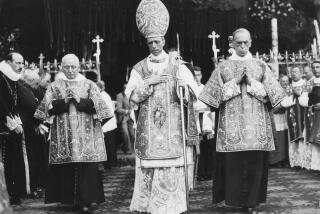Brazil Exhumes Body Believed to Be Mengele’s
SAO PAULO, Brazil — Aided by information from West German authorities, Brazilian police Thursday exhumed the remains of a man they believe was fugitive Nazi war criminal Josef Mengele, the death camp doctor of Auschwitz.
Brazilian authorities said that forensic experts from the United States, West Germany and Israel were en route here today to examine the remains, a study that they warned could take as long as two weeks.
Some Nazi-hunters who have long searched for Mengele, dubbed the “angel of death” and accused of responsibility for the deaths of 300,000 to 400,000 Jews at Auschwitz concentration camp in Poland during World War II, expressed skepticism that the body is that of the notorious war criminal.
Colonial Town Grave
The remains were raised Thursday from a grave in a cemetery in the pretty colonial town of Embu, 40 miles southwest of this Brazilian industrial center.
Police wearing black rubber gloves removed the remains from a plain wooden coffin bearing the name Wolfgang Gerhard, who was described as an Austrian mechanic when he drowned at a nearby South Atlantic beach in 1979.
An elderly couple, who knew the man and had rented him a house in the town of Eldorado Paulista near Embu, told Brazilian police that he had confessed to them that he was Mengele.
Wolfran Bissert and his wife, who have lived in Brazil for 30 years, accompanied police to the exhumation Thursday. Earlier this week, police found documents, photos, and a diary in the Bisserts’ house, and they said later it is convincing evidence that the body in Gerhard’s grave is actually that of Mengele.
Brazilian television Thursday night referred to Wolfran Bissert as “a former Nazi corporal.”
Sao Paulo Police Chief Romeo Tuma, regarded as one of Brazil’s most professional police commanders, said that he is “90% convinced” that the long search for Mengele has at last ended.
He said Brazilian authorities acted after West German authorities forwarded information on three families in Brazil, one of them the Bisserts, who were said to have been friendly with Mengele. By one account, the basis of the West German information is letters from the man known as Gerhard to members of the Mengele family still living in West Germany.
Tuma said that three West German police agents arrived here Tuesday to assist Brazilian police.
Many details were still lacking Thursday night but the police chief gave this account:
Man ‘On the Run’
The Bisserts were introduced around 1970 by the real Gerhard to a man he said was “on the run, in trouble because of the war.” They gave shelter to the man, who confessed to them a year later that he indeed was Mengele.
The real Gerhard, Tuma said, was found dead beside his car in Austria six months before the man believed to be Mengele drowned.
The grave from which the body was exhumed Thursday had apparently not been visited since soon after it was dug in 1979, police said.
Next to the grave is that of Gerhard’s mother, Friderieke, who was buried in 1961 after her death at age 66. The mother’s grave was not disturbed by the two gravediggers, who attacked the solid red clay with picks and shovels.
One of the gravediggers broke open the lid of the coffin and then removed the bones. The exhumation was shown live on Brazilian television.
Travel Pattern Cited
American law enforcement sources in Washington said Thursday that they “would not be surprised” if the body turned out to be that of Mengele, noting that the location of the grave would fit in with his apparent pattern of travel in South America.
The sources said that West German investigators are taking dental records to Brazil to help in the investigation, but there was some confusion on this point. The Associated Press quoted the leading West German law enforcement official on the case, Heinz Haueisen, public prosecutor in Frankfurt, as saying:
“We don’t have dental records of Mengele. We don’t have bone structure records either. One of the most important factors is to compare the size of the body with the size of Mengele. If it’s bigger or smaller then at least we’ll know it’s not him.”
The remains raised Thursday included a skull, the jaw of which held seven teeth. Another key point of comparison will be a bone in the left hand, which Mengele reportedly broke when he was nine years old. Tuma said he is confident that modern forensic techniques will be able to reveal evidence of the old fracture.
Escape From Germany
Mengele, who would be 74 if he is still alive, has been the object of an intensified international search coinciding with the 40th anniversary of the end of World War II in Europe. He is known to have escaped to South America from a collapsing Nazi Germany and to have lived for a time in Argentina and in Paraguay.
Nazi hunters, who placed advertisements in South American newspapers last month offering a total reward of $2.375 million for Mengele, have recently asserted that he is still alive and living in Paraguay, which granted him citizenship in 1959. Paraguay canceled his citizenship in 1979, and the government says today that he has not lived there for many years.
Brazilian police, by contrast, believe that he left Paraguay for Brazil around 1969 and lived here for 10 years until drowning late one afternoon while swimming at a beach called Bertioga. In New York on Thursday, perhaps the best known Nazi-hunter, Simon Wiesenthal, said he is almost 100% certain that the exhumed body is not that of Mengele. Reuters news agency quoted Wiesenthal as saying, “I will believe that it’s Mengele when his wife says he is dead, when his son says he is dead, and when his lawyer says he is dead.
“This is not the first time that there have been reports that he’s dead or that we have had false information. I don’t see ingredients in this that I can believe.”
Nazi-Hunter Klarsfeld
Another Nazi hunter, Beate Klarsfeld, who was recently in Paraguay demanding Mengele’s extradition, also reacted skeptically. In a television interview Thursday evening from West Berlin, she said that her recent trip led her to believe he is still in Paraguay.
“The police refused to open their books, and that shows they are still sheltering him,” she asserted.
In a statement from Paris, her husband, Serge, said he believes the new report is being circulated by Mengele’s friends to confuse the searchers.
In West Germany, Haueisen, the Frankfurt public prosecutor, said Thursday that he believes the exhumed body could be that of Mengele. “It’s a feeling, based on experience, that this time something could be there.”
Speaking in a telephone interview, he said, “At this point we can’t exclude anything. We can’t exclude that it is the body of Mengele that is in Sao Paulo and we can’t exclude that this might be just one more false trail.”
It was in Frankfurt that the first warrant was issued, in 1959, for Mengele’s arrest in connection with trials that dealt with events in the German concentration camp at Auschwitz, Poland, during World War II.
Macabre Experiments
As prisoners arrived there, Mengele, the camp’s chief physician, indicated with a gloved hand which were to go directly to the gas chambers and which were to be used for forced labor or medical experiments. His fascination with twins led to macabre, pseudo-scientific experiments.
Haueisen said that the grave in Brazil was opened as the result of information brought to light in the past 10 days in the Bavarian town of Guenzburg, about 70 miles west of Munich, where two of Mengele’s nephews live.
“This information leads us to believe that Mengele may have died under an assumed name in Sao Paulo in February, 1979,” Haueisen said. “It could all fall apart, but I think the possibility of it being strengthened is there.”
He said that documents found in Guenzburg led authorities to the home of the Bisserts in Brazil.
Haueisen said the Guenzburg information consists of “several written documents” and includes correspondence. “The evidence is very new,” he emphasized. “This has all happened within the past 10 days.”
Extensive Review
He said the decision to send investigators to Guenzburg followed an extensive, detailed review of existing evidence rather than any new reports. Haueisen made it clear that nothing less than positive identification of the exhumed body would be regarded as conclusive proof, but his confident mood was unusual for West German officials dealing with the Mengele case.
The Mengele nephews, Karl-Heinz and Dieter Mengele, run a farm machinery business in Guenzburg. Thursday, neither man was at the office, which was closed for the Corpus Christi holiday.
Mengele was born in Guenzburg on March 16, 1911. He studied philosophy at Munich University, then went to Frankfurt, where he was educated in medicine.
He became entranced with Adolf Hitler’s racial theories and, at age 22, joined the staff of the Nazi government’s Institute of Hereditary Biology and Race Research.
When the war came, Mengele joined the Waffen SS, the military arm of the Schutzstaffel, which had been formed as Hitler’s personal bodyguard. He served as a medical officer with the German invading forces in France and the Soviet Union and in 1943 was appointed chief physician at Auschwitz.
Hitler’s Vision
He was customarily on hand when trains filled with prisoners arrived. He determined which would live and which would die and he kept an eye out for twins, for he believed that they might provide clues to stimulating multiple births.
William D. Montalbano reported from Sao Paulo and Tyler Marshall from Bonn.
More to Read
Sign up for Essential California
The most important California stories and recommendations in your inbox every morning.
You may occasionally receive promotional content from the Los Angeles Times.










